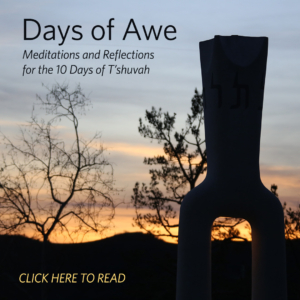From now through Yom Kippur, each of our Daily Kavanot will feature a piece written by our clergy on the themes and traditions of the High Holy Days. Each of these pieces can be found in Days of Awe, our High Holy Day Machzor supplement.
Everything Is In It
By Cantor Emma Lutz
בֶּן בַּג בַּג אוֹמֵר, הֲפֹךְ בָּהּ וַהֲפֹךְ בָּהּ, דְּכֹלָּא בָהּ
“Ben Bag Bag said: turn it and turn it again and again, for everything is in it.”
—Pirkei Avot 5:22
Together in the days ahead, we will participate in the communal observance of the Yamim Noraim, the 10 Days of Awe. For many hours, sometimes for multiple days in a row, we will sit together in our spectacular sanctuary or outside on our plaza and put our all efforts into prayer. Ben Bag Bag, a rabbinic disciple of the great Rabbi Hillel, teaches that we are meant to turn the words of prayer and study over and over again, leaning into repetition as a pathway toward enriching our learning and finding meaning in our worship. Everything that we seek—all lessons and enlightenment and connection—is laid out before us within our tradition, and it is up to us to visit and revisit these teachings in order that we might be our best selves and live deeply meaningful lives.
It sounds so simple on the surface: If we can just focus on the wisdom of our great tradition, then we can be our best selves and get the most out of life! And yet, we all know full well that the wisdom we seek is often elusive, and enlightenment rarely comes so simply, swiftly, or easily. So, what are we to do? How might we lean into Ben Bag Bag’s teaching, particularly at this time of year, as we turn our tradition over and over again until we can eke out a worthy path of t’shuvah—of repentance and returning to our best selves—that fits and works?
Our machzor (High Holy Day prayer book) is designed so that our thoughts and prayers have room to meander; we have the words of the traditional prayers in Hebrew, English, and transliteration, as well as notes that explain the blessings and interpretive readings that might offer a different perspective or point of access. Throughout the 10 days, your clergy will remind you to explore your own path in the worship process, to stay in the moment with our communal prayer or to allow your minds and hearts to wander in and out of the words of the machzor at your own pace. Each year, our High Holy Day prayers stay the same, but it is our repeated seeking, our intentional revisiting of these words and ideas, that reinforce the lessons of t’shuvah.
We recite the same prayers every year, but we change. What we bring to the prayer also changes from year to year. Everything that we seek is in it, if only we might allow ourselves to lean into the repetition, to transcend the purely cognitive, to find our own pace and rhythm within the music and prayer structure to set ourselves up for a better year ahead mentally, emotionally, and spiritually. May these Yamim Noraim be enriching and may our individual and collective prayers move us into a sweet 5784.

